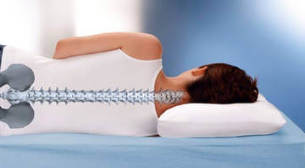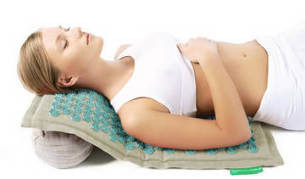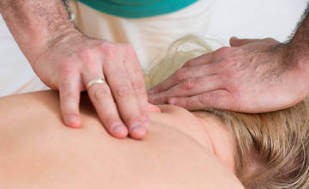
The progressive process of cervical spine osteochondrosis is dystrophy, disruption of the intervertebral discs.
Symptoms of osteochondrosis of the neck are characterized by severe pain in the neck, head, and shoulders, and affect everyone, regardless of age.
DESCRIPTION OF OSTEOCHONDROSIS
Cervical osteochondrosis has become much younger. Young people suffer from adolescence. The neck is the weakest area of the spine. Seven vertebrae are quite tightly connected to each other, and the muscle skeleton develops worse than the other sections. The neck is under severe stress because it serves as a support for the skull and is in constant motion.
What is cervical osteochondrosis? Intervertebral plates are fed by diffusion of adjacent tissues. Deterioration in the blood supply to the tissues surrounding the vertebrae leads to a lack of food and water. Starvation of the disc nucleus and annulus fibrosus leads to degenerative processes.
Bone tissue growing near the vertebrae, pinched vertebrae, and nerve and ligament bites first appear as signs of decreased performance. High-intensity pain is initially concentrated in the neck, head, shoulders, heart, arms, upper chest, moving toward the lower limbs. Each of the seven vertebrae sends signals to other classes. Compressed nerve roots affect the condition of other body systems.
Osteochondrosis is especially dangerous for the brain. The vertebral artery running here supplies the blood supply to the back of the brain. Its sting leads to a headache, often developing into a migraine that does not have an analgesic effect. Osteochondrosis of the neck may be accompanied by dizziness, visual and hearing impairment, nausea and vomiting. Later, symptoms of the pharynx appear, suddenly fainting due to a lack of oxygen supply to the brain. Compression of the vertebral artery leads to ischemia of the spinal cord and brain. Exacerbation of the process causes spinal cord stroke.
BASIC DISEASE PROCESSES
Osteochondrosis of the neck should be considered in terms of the interaction of physiological and pathological factors:
- Physiological process:Aging of the cartilage of the spine occurs for natural irreversible reasons. Changes occur in the central part of the intervertebral disc. The process of age-related changes in the body leads to the replacement of pulp with fibrous tissues;
- pathological process:there are degenerative changes in intervertebral structures, destruction of surrounding blood vessels and nodes. The changes take place outside the cartilage itself, there is a compression of the blood vessels, irritation of the nerve endings. A person feels dysalgia, local and reflective pain symptoms.
Osteochondrosis of the cervical spine has an abnormal form when physiological aging is replaced by an abnormal process. Initially, the body’s compensatory and protective mechanisms are triggered, eliminating the disease. Therefore, osteochondrosis can only pass or occur sporadically. But this feature is not permanent.
The progression of the disease, expressed as the compression of vascular and neural structures, is accompanied by the following processes:
- spondylolisthesis in which the spinal disc slips. Even a small shift leads to paralysis. Severe displacement is fatal;
- the nucleus pulposus is impregnated with calcium salts. This leads to plate malnutrition, provoking the formation of a hernia;
- Intervertebral hernia due to protrusion of the intervertebral disc between the vertebrae. Ignoring therapeutic measures leads to flabby paralysis;
- appearance of microcracks on the annulus fibrosis, formation of the protrusion. The intervertebral disc extends beyond its boundary;
- spondylosis, which means wear on the vertebrae. Osteophytes appear - bone tissue growths in the form of hooks and thorns located on the side of the vertebral bodies. There is severe pain and as a result there is stiffness in the movements.
CAUSES OF OSTECHONDROSIS OF THE NECK

Increasing the load on the cervical spine results in the body trying to compensate for the condition. This is how muscle cramps, deterioration of blood circulation, deformities begin. The structure of the vertebrae itself changes. This can also be due to progressive discosis due to prolonged physical exertion.
Main causes of cervical osteochondrosis:
- hypodynamics;
- weakening of the immune system;
- excessive physical activity;
- Presence of spinal cord injuries;
- nutritional deficiency of essential substances, obesity;
- posture problems (scoliosis, flat feet, rheumatism);
- hereditary factor;
- autoimmune diseases that cause cartilage degeneration;
- stress, prolonged nervous tension;
- climatic factor, cold and humidity;
- Congenital disorders of the spine.
The main causes of osteochondrosis are disproportionate distribution of spinal load, too weak muscle ligament. People over the age of thirty are at greatest risk, especially if they spend their days sitting for long periods of time.
DEVELOPMENT STAGES
The progression of cervical spinal osteochondrosis can be divided into several stages:
- first, preclinical.It is characterized by mild deformity of the vertebrae, smoothness of cervical lordosis. The pain is felt with sudden movements of the head, fatigue occurs. The development of the disease can be prevented by medication. You need to balance your diet, choose your exercises, and implement preventative measures;
- seconds.An unstable state is created between the vertebrae. There are displacements of the vertebrae relative to each other, torsion - rotation around the spine. The pain, which sometimes intensifies with the movement of the neck, radiates to the shoulders and arms. The height of the intervertebral discs decreases, leading to nerve constriction. It is characterized by signs such as distraction, fatigue, headache;
- Third section.The height of the intervertebral disc decreases by a quarter relative to the upper disc. Deformities begin in the intervertebral joints. The lumen of the intervertebral foramen, the spinal canal, decreases. They feel strong pain all the time. The muscles begin to numb due to the onset of herniated intervertebral disc formation. The cervical spine loses its elasticity. The patient feels dizzy and weak.
The height of the intervertebral disc decreases significantly. The intervertebral discs are destroyed and replaced by connective tissue. Large osteophytes form at the back of the cervical spine. The spinal canal narrows greatly, provoking the development of myelopathy. The patient's condition worsens, with impaired coordination, dizziness, severe pain, and tinnitus.
SYMPTOMS
The symptom pattern of the cervical lesion is different from the abnormalities in the other parts. This is due to the denser arrangement of the vertebrae relative to each other. Due to the low height of the intervertebral discs, the clinic also begins to manifest itself with mild pathologies. Signs of injury vary depending on which of the eight nerve roots is affected. There is a nerve under each of the seven vertebrae, and its compression has its own symptoms.
The problems of the first two vertebrae affect the sensitivity of the cervical vertebra. The pain is localized in the parietal, occipital region. Defeat of the nerve endings of the third vertebra is rare. The symptoms are manifested in numbness of the pinched area, in the language, in the problems of speech. The fourth root indicates a problem with pain and numbness in the clavicle, shoulder. May cause difficulty breathing and pain in the heart. The disease of the fifth segment causes pain in the shoulders, decreased sensitivity of the limbs.
Lesions of the sixth and seventh vertebrae are the most common in patients. The neck, the shoulder blades, the forearm, the lower back, the back suffer. There is numbness in the hands and fingers. Pathological changes in the eighth nerve root are characterized by the spread of pain in the lower extremities. The sensitivity of the skin decreases and the fingers of the hands and feet become numb. Damage to the bloodstream causes blue legs and hands.
Common signs of osteochondrosis of the neck include:
- pain in the upper body and lower body;
- weakness, decreased sensitivity of the hands;
- heavy movement, crunching;
- accompanied by impaired coordination, ringing, tinnitus, disorientation, weakness, dizziness;
- nausea, vomiting;
- Tongue, numbness of fingers and toes, hearing loss, vision.
NECK OSTECHONDROSIS DIAGNOSTICS
To determine the extent of damaged intervertebral discs and their disease, your doctor will need to perform a number of tests: X-rays, MRI, CT (computed tomography), ultrasound duplex scanning. Magnetic resonance imaging (MRI) is the most accurate way to examine the health of the cervical spine. The purpose of MRI is to identify abnormalities in the tissues of the spinal column, especially in the spinal cord and intervertebral hernias. After the patient is examined and questioned, the treating neurologist makes a preliminary diagnosis and prescribes the treatment.
MANAGEMENT

If you suspect osteochondrosis, you should consult a neurologist. The duration of therapy depends on the person's age, the severity of osteochondrosis of the neck, the type of therapy, and whether the patient meets all the doctor's recommendations. Complete cure of severe forms of osteochondrosis is impossible. The aim of the complex treatment is to slow down the ongoing pathological process and to eliminate the symptoms. Therapy can be conservative, operative, or a combination of both. If the headache becomes more frequent, therapy should be started as early as possible.
There are two main types of treatment for cervical osteochondrosis:
- medication taken while taking medications;
- physiotherapy includes courses in UHF, electrophoresis, ultrasound, magnetotherapy, and laser therapy. They stimulate blood flow, metabolism and remove muscle cramps.
Drug therapy is used to weaken the compression of the peripheral zones of the central nervous system (CNS) and to compensate for the pain syndrome as the disease worsens. After cessation of the acute manifestations of osteochondrosis of the neck, therapy is not stopped. They prescribe physiotherapy. The neck area should be massaged regularly. Folk remedies are also used.
PHARMACY THERAPY FOR OSTEOCHONDROSIS
Medication only has its full effect in combination with other methods, such as physiotherapy exercises (exercise therapy) and massage. The drugs are designed to relieve pain, restore cartilage tissue regeneration, and activate blood circulation in the affected neck tissues.

Many doctors prescribe injections that are more effective than nerve endings. But vitamins can best be taken in tablet form as injections are very painful. To achieve an anti-inflammatory effect, your doctor will give you intramuscular injections.
The main types of therapeutic drugs are:
- Non-steroidal anti-inflammatory drugs (NSAIDs).They have an analgesic effect, they remove the aseptic inflammatory process, the root edema. With obvious signs of the disease, these drugs are injected twice a day. Use cream topically;
- Chondroprotectors.Activates metabolism, regenerates cartilage tissue. Repair the damage to the intervertebral discs. There are injectable medications inside the joints and muscles. The process of therapy is up to 4 months;
- Group B (B1, B2, B6), Vitamins E, A, C, Dhelp to improve the metabolism of tissues, catalyze their healing;
- muscle relaxants.To relax spasmodic muscles. The tablets are used within a month. Various drugs that can be injected in the severe form of the disease are used;
- drugs to activate blood flow to the brain,rheological properties of blood.
The following are additional medicines to speed up your recovery:
- angioprotectors- injection forms of drugs are designed to activate the blood flow in the veins and to strengthen the vascular tone;
- glucocorticosteroids- to reduce edema and inflammation in the form of injections;
- biogenic stimulants.Accelerates metabolic processes, helps to recover destroyed tissues.
PHYSIOTHERAPY
Physiotherapy methods complement medication, significantly increase the rate of healing, prolong the remission phase, and reduce the frequency of exacerbations.
Physiotherapy methods:

- exerciseis one of the most effective ways to treat osteochondrosis. Regular exercise activates blood circulation, helps to repair damage;
- massageimproves nerve conduction, restores muscle tone;
- magnetic therapyrelieves tissue edema;
- laser therapyworks with a concentrated optical beam of light. Initiates body recovery processes;
- Reflexology- Activate certain points. Strengthens the immune system, relieves cramps and neck pain;
- ultrasoundhas an analgesic, anti-inflammatory effect;
- electrophoresis with herbs.Electric current helps drug ions penetrate a given location.
Manual therapy, heat therapy, mud therapy are also used to get rid of osteochondrosis of the neck. All of these methods slow down the progression of the disease.
It is impossible to cure osteochondrosis with herbs, but accompanying the main therapy will help alleviate the condition. Mix 2 teaspoons of bee honey with two mummy tablets. The mixture is heated and spread on a warm scarf, which is tied around the neck at night. The biostimulating properties of honey perfectly complement the treatment. For grinding, use a tincture of radish, vodka and honey, measured in a glass in a ratio of 1: 5: 0, 5: 1. You can twist three large lemons with a meat grinder and four garlic cloves. Pour hot water over the mixture in a two-liter container. After mixing the contents, drink half a glass on an empty stomach. The pain can also be relieved by warming it with mustard plasters and pepper plaster.
HEALING PRACTICES
During the healing period, you can perform a series of therapeutic exercises for the neck. Movement therapy is based on several dynamic practices. Do not get worse during exercise. It is recommended to monitor the appearance of discomfort when performing exercises, this is unacceptable.
Lift your upper body with your arms out of position. Delay for 1-2 minutes. Lower to starting position and repeat 2-3 times. You should then extend your arms along your body. Head turns left and right are performed 6-7 times, trying to reach the floor with the tab. Sit down. While inhaling, tilt your body forward, head tilted toward chest. When exhaling, lean back, throw your head back. Quite 10-15 tendencies. Now you need to put your palm on your forehead and apply mutual pressure for 30 seconds. Repeat 2-3 times. Rotate your head 10 times in both directions. If your head starts to rotate, the exercise should be stopped.
COMPLICATIONS

The cervical region feeds the brain rich in blood vessels and nerve endings. The slightest compression damages the whole body, disrupting blood circulation to the brain and causing neurological disorders: migraines, heart, respiratory system, vision, hearing, hypertension disorders. Particularly dangerous complications in the form of vertebral artery syndrome, cerebral ischemia, spinal cord stroke, which result from an advanced form of cervical disease. When radiculopathy occurs, mobility is lost. Spinal cord compression is fatal.
To avoid surgery in the treatment of osteochondrosis of the cervix, medical care should not be delayed at the first sign. It is necessary to use all available therapeutic methods, as well as to change lifestyle and diet.













































